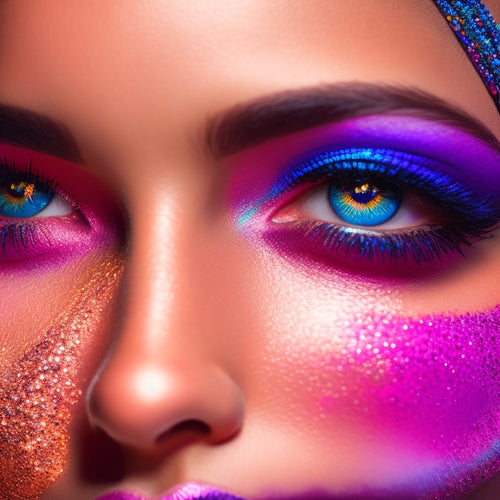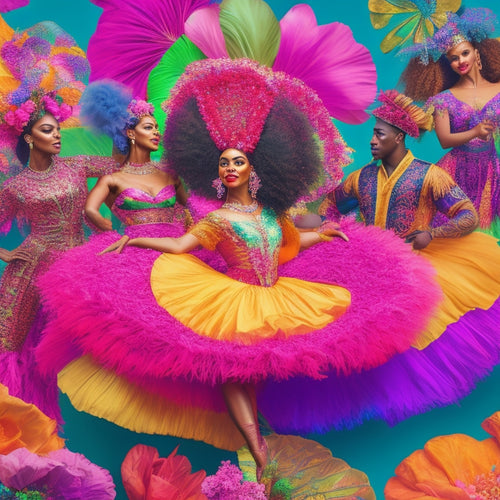
Can I Become a Dancer at Home?
Share
You can take the first step towards becoming a skilled dancer from the comfort of your own home, where you can learn, practice, and perfect your craft at your own pace. Clear a dedicated space, invest in a good sound system, and choose online classes that fit your style and schedule. Establish a consistent practice routine, focusing on building strength, flexibility, and technique. As you progress, you'll develop your unique style and flair. With dedication and persistence, you'll be well on your way to becoming a confident dancer. Now, discover the secrets to revealing your full potential.
Key Takeaways
• Create a dedicated dance space at home with a smooth surface, good sound system, and minimal distractions to focus on your dance practice.
• Choose online dance classes that fit your style, skill level, and schedule to learn from experienced instructors and gain confidence.
• Establish a consistent practice schedule with time for warm-up, technique, choreography, and reflection to improve technique and build confidence.
• Focus on building strength and flexibility through exercises that target core engagement, alignment, and controlled movements to enhance overall dance technique.
• Develop your unique dance style by infusing your personality, responding to music, and experimenting with movements to find your authentic dance voice.
Setting Up Your Home Dance Space
To transform any room into a functional dance space, start by clearing a large, open area free from breakable objects and tripping hazards. You'll want a smooth, unobstructed surface to move freely.
Consider your flooring options - a wooden or tile floor is ideal, but even a carpeted room can work with the right shoes.
Next, think about your sound system. You'll need a way to play your music loud and clear. Invest in a good sound system or speaker that can fill the room with high-quality sound. This will help you get in the zone and stay motivated.
With a clear space and great sound, you're one step closer to becoming a dancer at home.
Choosing Online Dance Classes
With a dance space set up, you're ready to start learning, and with the vast array of online dance classes available, you can find a style and instructor that suits your needs and schedule. You can explore different dance genres, from hip hop to contemporary, and find classes that cater to your skill level and interests.
Here are some tips to help you choose the right online dance classes for you:
-
Explore learning platforms: Websites like DanceWithMe, MasterClass, and Codarts offer a range of classes and instructors.
-
Read reviews and testimonials: Get a sense of the instructor's teaching style and the class's level of difficulty.
-
Try out a class: Many platforms offer free trials or introductory classes, so take advantage of these to find the best fit for you.
Creating a Practice Schedule
As you settle into your dance space and explore online classes, establishing a consistent practice schedule becomes essential to your progress and motivation. By setting aside dedicated time, you'll improve your technique, build confidence, and stay committed to your dance journey. Effective time management is key to achieving your goals.
| Day | Time | Focus |
|---|---|---|
| Monday | 30 minutes | Warm-up and stretching |
| Wednesday | 45 minutes | Technical practice (e.g., pirouettes) |
| Friday | 60 minutes | Choreography and performance |
| Sunday | 30 minutes | Cool-down and reflection |
| Daily | 10 minutes | Goal setting and journaling |
Building Strength and Flexibility
You'll need a strong, flexible body to execute complex dance movements with precision and control, so it's time to focus on building your overall strength and flexibility.
As you start this journey, remember that a strong foundation is key to mastering dance techniques. To achieve this, focus on:
-
Proper Alignment: Engage your core and maintain a straight spine to improve your overall posture and balance.
-
Core Engagement: Activate your core muscles to stabilize your body and generate power for movements.
-
Controlled Movements: Practice slow, controlled movements to build strength and precision in your muscles.
Developing Your Own Style
Developing your own style is a natural progression of mastering dance techniques, and now it's time to infuse your unique personality and flair into your movements.
As you explore your personal narrative, you'll find that your dance style is a reflection of who you are. It's crucial to connect with the music, allowing your body to respond authentically to the rhythm and melody.
This is where musical expression comes in – let the music guide your movements, and don't be afraid to experiment.
Frequently Asked Questions
Do I Need to Be Naturally Flexible to Become a Good Dancer?
"You're thinking you need to be a human rubber band to become a good dancer? Not necessarily! While some dancers are naturally flexible, you can still develop your flexibility with consistent exercises, and it's not all about dance genetics - it's about dedication and practice."
Can I Learn Dance if I Have a Physical Disability or Injury?
You can still learn dance with a physical disability or injury; explore accessible choreography and adaptive techniques tailored to your needs, empowering you to express yourself through movement.
How Long Does It Take to See Progress in My Dancing Skills?
"Rome wasn't built in a day," but with daily practice and a consistent routine, you'll start to see progress in your dancing skills within a few weeks to a few months, depending on your dedication and effort.
Will Dancing at Home Help Me Lose Weight or Get Toned?
"You'll be thrilled to know that dancing at home can indeed help you lose weight and get toned! As you dance, you'll experience a significant calorie burn, plus body sculpting benefits, shaping your physique and boosting confidence."
Do I Need to Perform in Front of an Audience to Be a Dancer?
"You don't need to perform in front of a live audience to be a 'real' dancer - solo performances on virtual stages can be just as powerful, and you can still shine in the comfort of your own space."
Related Posts
-

Revolutionize Your Dance Makeup With Pro Tutorials
You're about to discover the hidden gems of your dance makeup skills with the latest digital tools and expert guidanc...
-

Best Ballet Dancer Accessories for Peak Performance
To open up your peak performance as a ballet dancer, invest in vital accessories. Start with well-fitted footwear—cho...
-

Dance Dress Code: Unleash Your Style
A dance dress code that prioritizes functionality and technical precision can often stifle dancers' ability to expres...


